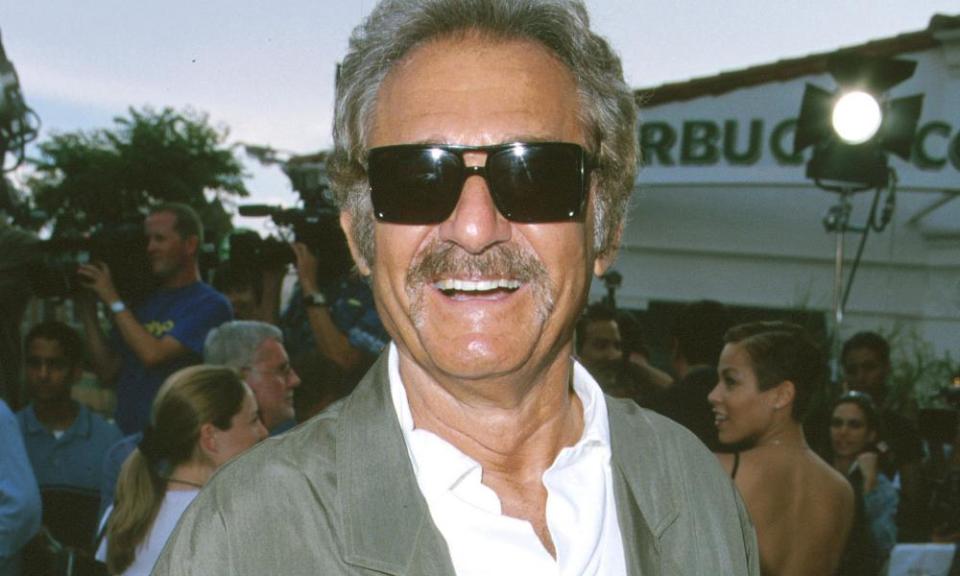Richard Rush obituary
With admirers including Stanley Kubrick, François Truffaut and Quentin Tarantino, Richard Rush could with some justification be called the directors’ director. Whether making cheap, hastily-shot exploitation films for Roger Corman’s AIP (American International Pictures) or starry comedies for major studios, Rush, who has died aged 91, had a subversive sensibility, as well as a sympathetic fascination with the counterculture.
His outstanding achievement was The Stunt Man (1980), a devilishly inventive film about film-making. Based on the novel by Paul Brodeur, it concerns a fugitive who stumbles unwittingly on to a movie set, gets hired as a stunt performer, and starts to believe that the flamboyant, maniacal director, who is shooting a first world war picture, is trying to kill him.
That fictional film-maker, who keeps appearing unheralded from the heavens in a helicopter or on a camera crane, was a gift of a role. After reading the script, adapted by Rush and Lawrence B Marcus, the actor Peter O’Toole told the director: “If you don’t let me play the part, I will kill you.” His performance was simultaneously broad and acutely observed, and that balance was reflected in the movie, with Rush juggling comedy, action and wry industry insights with skill. One highlight is the painstakingly choreographed, deliriously enjoyable opening sequence, in which a string of minor events ends, with a satisfying domino effect, in the death of a stunt driver.

O’Toole received an Oscar nomination, while Rush was recognised in both the director and adapted screenplay categories. It was a vindication for him after shopping the script around since the early 1970s without success. He later admitted he would have been disappointed if it had not been in the running for any prizes. “I thought [The Stunt Man] was the best fucking thing that anybody ever did,” he said.
Even once the film began getting rave reviews from critics, including the New Yorker’s Pauline Kael (who called it “a virtuoso piece of kinetic moviemaking”), the film’s release was mishandled by 20th Century Fox, which seemed unable to decide whether to promote it as farce, satire, action spectacular or art film. “It didn’t fit into the wrapper that the distributors had prepared that they send their hamburgers out in,” Rush said.
Born in New York City, Rush was the child of what he called “politically and socially rebellious parents”. His family moved to Los Angeles when he was seven. He was educated at Los Angeles high school and later at UCLA, where he was part of the inaugural film class. He joined the US air force’s film-making unit and directed propaganda films about the Korean war, then made his feature debut with the teen romance Too Soon to Love (1960). Among its young cast was Jack Nicholson, who also starred in Rush’s biker movie Hells Angels on Wheels (1967), featuring real members of the Hells Angels, and the hippy drama Psych-Out (1968), set in San Francisco’s Haight-Ashbury district.
As a formerly disruptive adolescent, Rush felt right at home at AIP. “Their films were made to appeal to teens,” he said, “and I knew how to reach them. My message was always: What do you need to overcome, and how can you accomplish that?”
He also directed the melodrama Of Love and Desire (1963), starring Merle Oberon; Thunder Alley (1967), about competitive auto racing; and a second biker film, The Savage Seven (1968). His formula was parlayed by others in 1969 into the ultimate biker movie: Easy Rider, which featured Nicholson and used many of Rush’s crew members, including his regular cinematographer, László Kovács. The director was rather taken aback. “I was flabbergasted when Bert [Schneider, the producer of Easy Rider] said, ‘I’m going to make a Dick Rush film.’ I wished him luck.”
Working next with a major star (Elliott Gould) and studio (Columbia) on the comedy Getting Straight (1970) did nothing to blunt Rush’s edge. He set the story, about a former activist studying for his master’s degree, among the anti-Vietnam war protests taking place at the time on US campuses. Opening the week after the Kent State University shootings in Ohio, when police killed four students, the film was timely and, in its shot of Gould joining the uprisings by lobbing a brick through a window, surprisingly incendiary.
With the raucous, knockabout Freebie and the Bean (1974), starring Alan Arkin and James Caan as bickering cops, Rush invented the buddy action-comedy as we know it today. Working with the intense, argumentative Arkin and Caan, he said, “turned into a living hell for a while”. But then, his career was never plain sailing. Even after the acclaim for The Stunt Man, he struggled to get films made. He came close to directing his Vietnam-set comedy script Air America, which had Sean Connery attached, but the project collapsed; it was eventually directed in 1990 by Roger Spottiswoode, starring Mel Gibson and Robert Downey Jr.
Rush took on Colour of Night (1994), a thriller starring Bruce Willis as a therapist, only in exchange for making a pet project called The Fat Lady, about Barry Seal, a real-life airline pilot turned drug smuggler. But not only did that fail to come to fruition (a different version, starring Tom Cruise as Seal, was released in 2017 as American Made) but Colour of Night was recut by its producers. Though Rush’s edit was restored for the home video market, the damage of its uniformly disparaging reviews had been done. He never directed another film.
He is survived by his wife, Claude (nee Cuvereaux), and their son, Anthony.
• Richard Rush, film director, born 15 April 1929; died 8 April 2021

 Yahoo Movies
Yahoo Movies 
